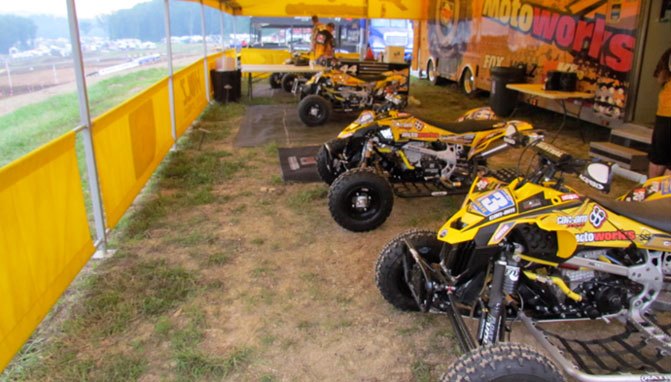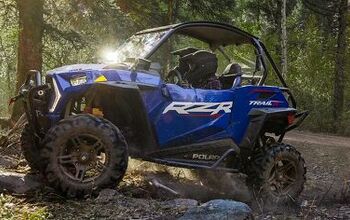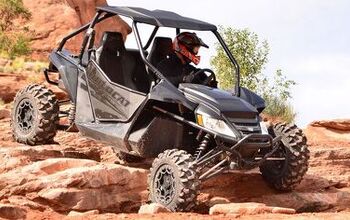The Sponsorship Game
Editor’s Note: ATV.com is going deep into the world of racing sponsorship with a three-part series. This is the first article in the series, which will look at the current economics of ATV racing.
They say they best way to become a millionaire by racing ATVs is to start as a billionaire. It’s no surprise to anyone that racing is expensive and while opportunities exist for racers to receive support, there are a number of factors that affect the level of support that industry companies are able to provide to both amateur and professional racers alike.
Rather than offer up another course on resume writing or giving you 10 tips to make yourself more attractive to potential sponsors, we thought we’d dig a little deeper and shed some light on the whole situation. Sure, we’ll get to resumes, social media and how you can go about finding supporters for your program, but we want to lend some insider’s perspective to an industry that has faced more ups and downs than the newest roller coaster at Six Flags. As we publish a series of articles in the coming weeks revolving around sponsorship, our goal is that you would gain a more clear understanding of how the industry works and just what it takes, collectively, for the powersports industry to thrive.
Bottom line – Understanding ROI
In 2003 LeBron James signed a contract with NIKE that would pay the then undrafted high school basketball star $90 million dollars over the course of seven years. Why would a company like Nike take such a risk and invest so much money in a teenager like James? Three words; return on investment. Nike believed James would be the next big thing in basketball and through brand partnerships and marketing campaigns, believed that it could make back all of that money and more.
That’s how sponsorship works. When a company gets behind an athlete or any kind of endorser, it has an expectation that that person is going to pull in enough interest, either by who they are or something they accomplish, that the company will eventually recoup there investment and then some.
The ATV industry works the same way. When a company supports a racer by way of free product or a discount, they have faith that that person is going to make good on their promise to compete, win races and otherwise promote its brand to paying customers. It makes no difference if it’s an amateur racer or a professional, the end goal is the same; sell more product. Companies have the right to make a contribution to help out a struggling racer, and many of them do knowing full well they probably won’t see much of a return. Unfortunately, as we’ll talk more about in a moment, that has created somewhat of an expectation on the part of ATV racers where they come to expect some form of support from industry companies and offer very little in return.
Realities of the ATV Industry
Contrary to popular belief, most companies that are actively present in the ATV industry are small, family owned businesses. Many of them started in a garage and eventually graduated to something a little bit larger. They don’t have massive staffs of people or large production facilities filled with multi-million dollar machines. They continue to port, bend, bore and machine their products by hand, the same way their families have for decades.
In the beginning, they started manufacturing products because they had a need themselves or found a way to improve upon an existing product and eventually decided to offer it for sale to the community. A community comprised of few, but loyal people who were willing to pay for a product or service.
Over time, and certainly as the economy has changed, people stopped being so inclined to pay for things. Costs rose and new competition moved into the marketplace, all while the number of people participating week after week had declined, making it harder to make a living from the existing customer base.
In an attempt to keep product moving, and for some just keep the lights on, many companies elect to offer a basic support discount to virtually anyone that asks. Because there are more companies fighting for fewer dollars being spent, selling discounted product is better than selling none at all. Some manufacturers also view this as an opportunity to keep customers away from the competition and, ideally, build a relationship with them that will span the entirety of their racing career.
“Any racer that sends us a resume will get some level of support” says Mike Walsh, owner of Walsh Race Craft. “We look at it as a way of giving back to the sport and hopefully, getting that person committed to our products from the get go and sticking with us for the long term. We do offer true sponsorships for top professionals, but at the same time we expect results. We offer support to amateurs and professionals alike, but we’re not going to make an investment in a back of the pack pro.”
Walsh’s strategy works, as not only does it offer a premium product, but the company has sought to stake its entire livelihood on the ATV industry. Where other companies have diversified and gone after the UTV market or thrown in the towel all together, Walsh continues to give back to the sport by investing in ATV racers, and then expects results.
Many manufacturers, particularly those who have held their ground as primarily ATV-centric companies, share Walsh’s mentality, providing some level of support to just about anyone who asks. This strategy has worked in some instances and in others, merely created an expectation on the part of the racer. This mindset is “If your company doesn’t offer to support me, then I don’t want your products.” This is vastly different from the way things used to be.
Sponsorship Then and Now
20 years ago, you’d be hard pressed to find a C class racer, at any series, receiving any level of support. Truth be told, you’d be lucky to get a discount on product even as an A class racer. Sponsorships, and by that we mean free or significantly discounted product, were available only to the best of the best. Only top-level athletes who competed at the highest level that had the ability to put products on the box and in front of the masses could receive support. There was an element of prestige to being sponsored by a company, because it meant that you were part of an elite group. You were one of only a handful of athletes, chosen to represent a given company at the pinnacle of the sport.
Consequently, what won on Sunday, sold on Monday. When only a handful of racers are getting free or discounted product, the rest of the field, and the vast majority of amateur racers, were paying for products. This allowed companies to invest in new products, new development, and give back to the industry by sponsoring series and helping ensure that the racers had an opportunity to compete.
As we’ve illustrated, the attitude towards sponsorship is very different today. Today, rookie racers and even first timers can find companies willing to offer them discounts on products simply because they race. Now don’t get us wrong; we understand that racing is expensive and there’s no shame in asking for help. But asking and expecting are two very different things and the lines between the two are getting more and more blurred.
One simple way to tell that a lot of racers are just out for whoever will give them the best deal is that they sponsor hop from one season the next. You might see them running Maxxis tires one year and Goldspeed tires the next. Or they might be running Houser nerf bars and bumpers and the following year they show up to the track with Rath products.
We understand that racing is expensive, but jumping ship just because someone will give you a better deal sends a few different messages. First, it doesn’t indicate that you believe in the company or the products you are using. It just shows that you are out for whoever will give you the best deal. Secondly, it sends the message to that company that you don’t appreciate the fact that they supported you to begin with. Other opportunities come along and both racers and companies need to understand that, but going back to the ROI conversation, the level of support that a racer believes he or she should receive and the level of exposure that company believes the racer will provide are often two different things.
Racers would do well to build relationships with companies who show their interested in supporting the sport and helping it grow. That might not mean always getting the level of support that you feel you deserve, but loyalty goes a long way in this industry. What’s more, every racer has the opportunity to show a company why he or she provides value and would make a good investment.
Opportunities for Growth
The ATV industry is a unique one. Despite zero manufacturer support and no new models released during the 1990s, the ATV industry plugged right along. Following the boom and then collapse of the economy in the 2000s, racer attendance may have declined, but it hasn’t dried up. That means there is still a market for companies to build and sell high performance products. But what is it going to take for the industry to move forward? We hear grumblings from time to time that ATV racers are upset with series and promoters because they just can’t seem to pull in the numbers that the big dirt bike events pull in. Why is that?
Several factors are at play, but one of the biggest realities is that companies have money to invest in a series when racers pay for products. A series grows, payouts get larger, and more people are attracted to the sport because they have a legitimate shot at making some money. When a company divides its support budget amongst a sea of amateur racers, it helps a lot of people make it to the track for another season, but that’s it. It doesn’t foster growth like it would if that same budget went towards creating a bigger event with more opportunity for the top racers to make money. And having the potential to eventually make money is enough for a lot of amateurs to keep striving. That’s how it was back in the 1990s, long before the factory teams made their return.
“When I got into the sport, there was always this rumor like ‘wouldn’t it be great if the factories got involved again?” says pro racer Jeremiah Jones. “None of us expected it, we just did it because we loved it. You start as an amateur, then you make it to the pro class and you start getting some free product and eventually, if you learn to market yourself, you might make a little bit of money.”
Jones speaks as one who’s experienced it all, from caravanning to the races with family to enjoying the spoils of a true factory race program.
“It’s different now,” says Jones. “Everybody’s got to have big rigs and multiple bikes just to get through the season. When I won my first championship we had a covered trailer and a Ford F150 pickup. I had one race bike and one practice bike to make it through the entire season and it had to.”
In some sense, many racers continue to live as if the glory days of factory teams are still present; when families could spend their money on a new motor coach instead of bikes and parts because all of that was taken care of. It’s not that way any more and the handful of companies that are still left are hustling to stay in business.
So what does that mean for racers, companies, and ATV racing series? The best advice we can offer is to partner with companies who are investing in the sport. That might not always mean you get the support discount that you feel you deserve, but the companies who are doing it right are investing in the longevity of the sport – in trying to create better events and bring in more numbers. You would do well to partner with these companies because they are the ones working to ensure you continue to have an opportunity to race long into the future.
Stay tuned to ATV.com for Part II of our sponsorship series, where we look at sponsorship etiquette and how to approach companies about sponsorship opportunities.
Growing up in Oregon, most of Seth's involvement in the powersports world was limited to what he saw in magazines and videos. Following a brief stint in the corporate world, Seth took a flying leap (literally) and moved to California to pursue a career in freestyle motocross. Though short lived, the opportunity immersed him in the industry and is now a well-established off-road writer.
More by Seth Fargher


















![MIT Student Develops Off-Road Wheelchair [video]](https://cdn-fastly.atv.com/media/2022/10/24/8744100/mit-student-develops-off-road-wheelchair-video.jpg?size=350x220)














